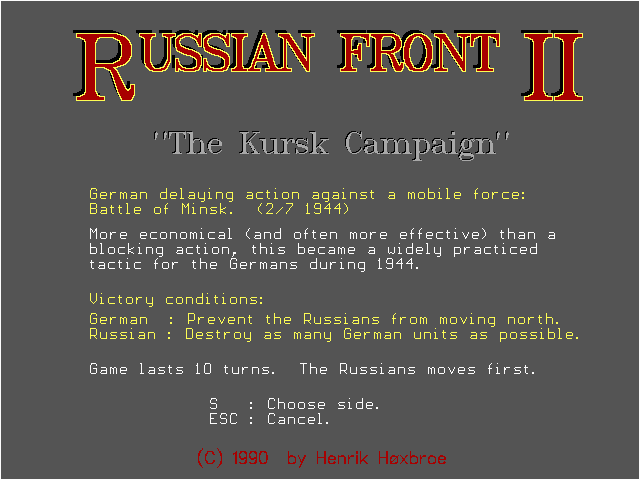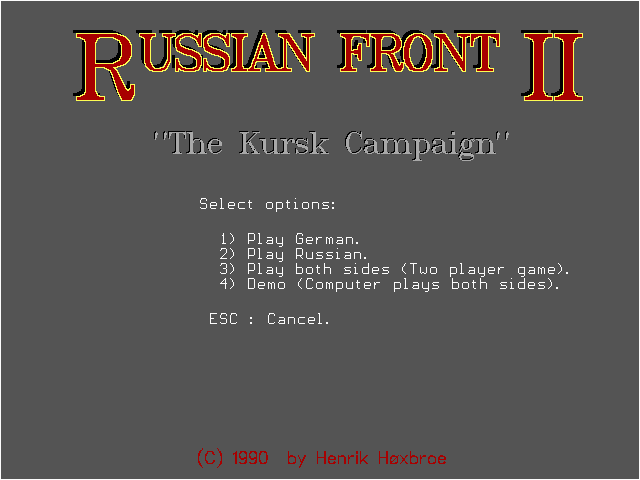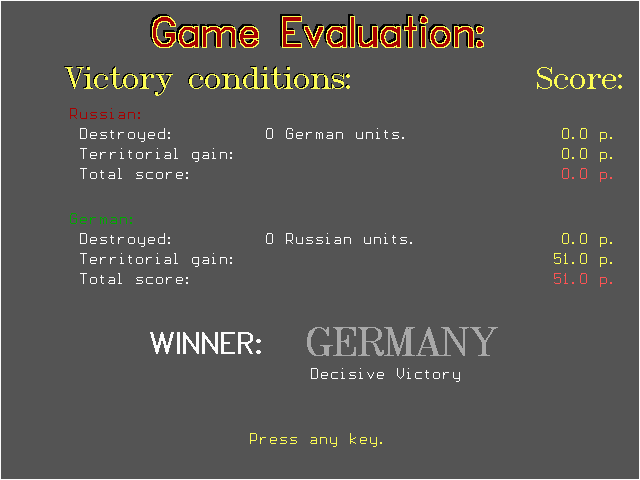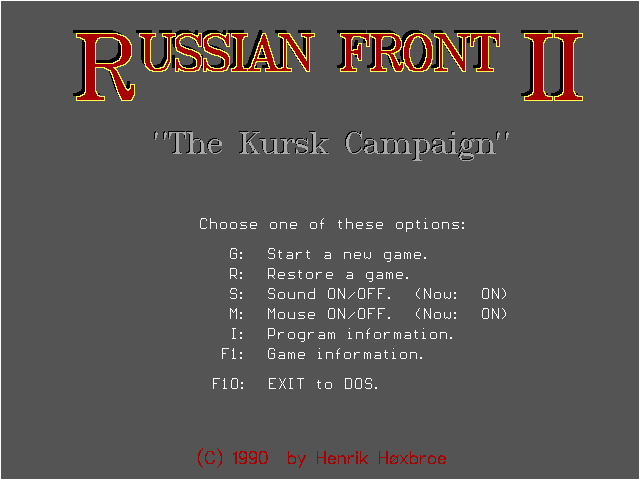Retro Replay Review
Gameplay
Russian Front II: The Kursk Campaign puts you in command of armored and infantry units on a square-grid map, recreating the classic feel of tabletop wargaming in digital form. Drawing heavily from Avalon Hill’s Panzerblitz mechanics, each unit occupies a single square with its own combat value and movement allowance. You plot moves in turns, advancing your tanks, infantry, and artillery in tight formations to seize key positions or to deliver decisive strikes against enemy forces.
The game offers three distinct scenarios set during the summer of 1943 and into 1944, each spanning 10–12 turns. Victory conditions hinge on both territorial control and enemy unit destruction, demanding a balanced approach of offensive thrusts and defensive holds. While the objectives vary from scenario to scenario, the underlying emphasis on combined arms tactics remains constant: coordinate your panzers with infantry support, exploit terrain advantages, and time your assaults to shatter enemy lines.
One of the most engaging aspects is the clear, methodical pace. There’s no real-time pressure—each decision is yours to ponder. This deliberate rhythm suits players who appreciate thinking through flanking maneuvers, supply line management, and concentration of force. Veteran players of Panzer General or Panzer Campaign will find the rules immediately familiar, from stacking limits to zone-of-control effects, while newcomers can pick up the basics with minimal handholding.
Unit management is straightforward: move, attack, and defend. Artillery bombardments soften up enemy squares before your tanks roll in, while anti-tank guns and dug-in infantry provide a sturdy defense. The interface clearly shows movement ranges, attack probabilities, and terrain modifiers, ensuring you’re never left guessing how your Panzer IV or T-34 will fare in open fields, forests, or urban ruins.
Graphics
Graphically, Russian Front II opts for utility over flash. The entire map is rendered in simple 2D icons on a color‐coded grid. Tanks, infantry squads, and artillery pieces are represented by small but distinctive counters, each marked with its unit type and strength. While this approach lacks the visual flair of modern wargames, it delivers clear information at a glance—no ambiguity about which square still offers defensive cover or which route exposes your forces to enemy fire.
The terrain graphics, although basic, are perfectly serviceable. Plains are a solid green, forests are darkened squares with tree icons, and rail lines or roads are thin lines that clearly indicate movement bonuses. Towns and key objectives stand out with simple building icons, making it easy to spot high-value targets on the hex-free grid. This clarity ensures that tactical planning stays front and center, rather than getting lost in flashy but distracting animations.
Unit animations are minimal to nonexistent; when you attack, the game simply calculates outcomes and updates unit strengths or removes destroyed pieces. Combat results are displayed numerically, often with color cues (red for losses, green for gains), so you always know how your army is holding up. While purists of AAA graphics might find the visuals outdated, fans of classic wargames will appreciate the unobtrusive design that keeps gameplay at the forefront.
Story
Rather than a cinematic narrative, Russian Front II delivers its story through scenario briefings and historical context. Each of the three scenarios opens with a description of the strategic situation—whether you’re the German defense seeking to hold the Orel salient or the Soviets gearing up for a massive counteroffensive at Kursk. These texts set the stage and outline the forces on field, but they leave the unfolding drama entirely in the player’s hands.
The absence of voiced cutscenes or character-driven subplots may disappoint those expecting a linear single-player campaign. However, this design choice mirrors the unpredictability of actual warfare: your actions write the story. A well-timed counterattack might rout German armor from a key crossroads, or a poorly executed assault could end in a devastating encirclement. Every playthrough generates its own emergent narrative of triumphs and setbacks.
For history buffs, the scenarios capture the ebb and flow of the Kursk campaign, including the famous minefields, fortified positions, and rapid Soviet reinforcements. While the game doesn’t delve into individual soldier experiences, it effectively conveys the high-stakes decision-making that shaped one of World War II’s largest tank battles. The result is a sandbox of historical possibility rather than a scripted tale.
Overall Experience
As a shareware title, Russian Front II: The Kursk Campaign excels at delivering old-school wargaming with minimal investment. Installation is quick, system requirements are low, and you can jump straight into the action without wrestling through elaborate tutorials. For players familiar with Avalon Hill classics or the Panzer Campaign series, the learning curve is hardly a curve at all—more of a smooth ramp into familiar territory.
Replayability is strong thanks to the trio of scenarios and variable victory conditions. Experimenting with different force compositions, timing your breakthroughs, or simply outmaneuvering the AI can lead to vastly different outcomes. Multiplayer hotseat or play-by-email options further extend the game’s lifespan, letting you test your tactics against human opponents who share your love of methodical, turn-based warfare.
While it won’t compete with modern titles on the graphical or cinematic front, Russian Front II shines where it counts for the dedicated wargamer: depth of strategy, historical fidelity, and clarity of execution. If you’ve enjoyed Panzerblitz on the tabletop or Panzer General on PC, this shareware offering is a cost-effective way to relive the Kursk offensive and refine your operational art.
In sum, Russian Front II: The Kursk Campaign is a lean, focused package that faithfully translates classic board-game mechanics into a digital experience. It rewards patience, strategic planning, and a willingness to think several moves ahead. For strategy enthusiasts seeking a no-frills dive into one of World War II’s pivotal battles, this shareware gem is well worth exploring.
 Retro Replay Retro Replay gaming reviews, news, emulation, geek stuff and more!
Retro Replay Retro Replay gaming reviews, news, emulation, geek stuff and more!









Reviews
There are no reviews yet.